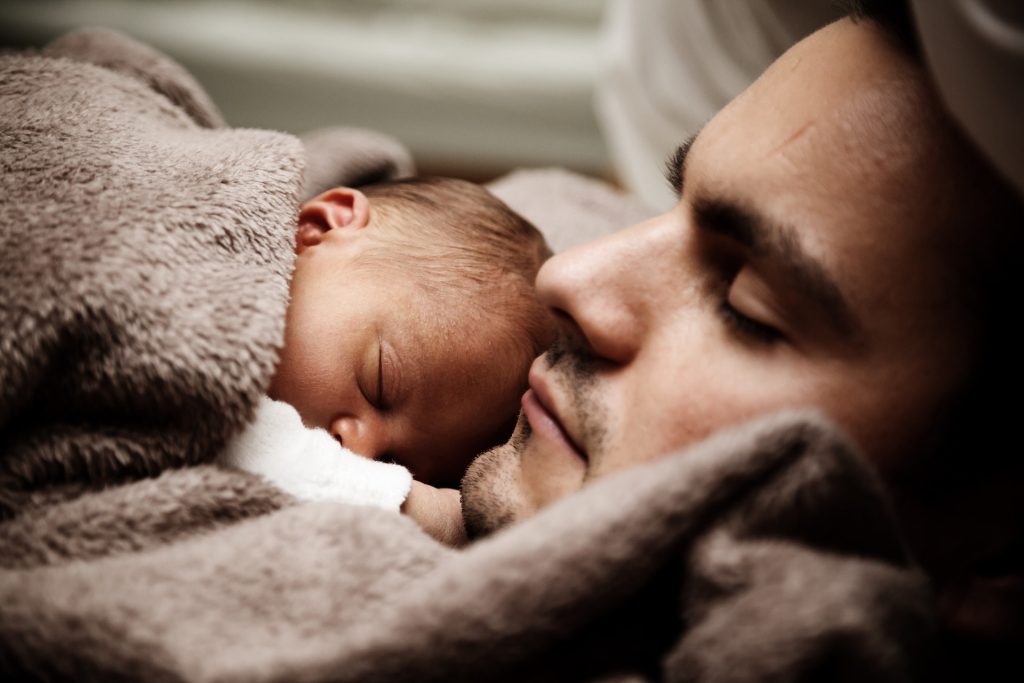Discover the impact of co-sleeping and breastfeeding on sleep positions and back pain.
How Co-Sleeping and Breastfeeding Affect Sleep Position and Back Pain
Sleep is a precious commodity for new parents, but it can often feel as elusive as a rainbow-colored unicorn. Co-sleeping and breastfeeding are two practices that many parents turn to, in hopes of getting more shut-eye. But what impact do these practices have on sleep position and back pain? In this article, we’ll explore the fascinating relationship between co-sleeping, breastfeeding, sleep position, and those pesky aches and pains.
Understanding Co-Sleeping and Breastfeeding

The Concept of Co-Sleeping
Co-sleeping, a practice that has been around since the dawn of humankind, involves babies sleeping close to their parents. This can be in the same bed or in a separate but attached sleeping environment. Many parents swear by co-sleeping, as they believe it fosters a stronger bond and enables them to respond quickly to their baby’s needs.
When a baby sleeps in close proximity to their parents, it creates a sense of security and comfort. The warmth and presence of their mother or father can help regulate the baby’s body temperature, heart rate, and breathing patterns. Additionally, co-sleeping can make nighttime breastfeeding more convenient, as the baby is within arm’s reach.
Co-sleeping practices vary across cultures. In some societies, it is the norm for families to share a bed, while in others, parents may choose to use a bedside bassinet or co-sleeper crib. Regardless of the specific arrangement, the underlying principle remains the same: keeping the baby close to their parents during sleep.
The Importance of Breastfeeding
Breastfeeding is a beautifully intimate act of nourishing a baby with mother’s milk. Its benefits extend far beyond nutrition, providing comfort and emotional bonding between mother and child. Breast milk contains essential nutrients and antibodies that help protect the baby from infections and diseases, boosting their immune system.
During nighttime feeds, breastfeeding can play a crucial role in establishing a healthy sleep routine for both the baby and the mother. The act of nursing releases hormones, such as oxytocin, which promote relaxation and a sense of calm. This can help the baby fall back to sleep more easily and reduce nighttime awakenings.
Furthermore, breastfeeding at night can enhance the mother’s sleep quality. The close physical contact and the release of oxytocin during breastfeeding can induce feelings of relaxation and contentment, making it easier for the mother to fall asleep after nursing her baby.
However, the logistics of breastfeeding during nighttime feeds can sometimes pose challenges. Finding a comfortable position, especially if co-sleeping, is essential to ensure both the mother and baby are at ease. It is important to create a safe sleep environment, free from hazards such as loose bedding or pillows that could potentially obstruct the baby’s airway.
Additionally, some mothers may experience back pain due to the prolonged periods of breastfeeding during the night. This can be attributed to poor posture or inadequate support while nursing. Taking steps to maintain good posture, using pillows or nursing aids for support, and practicing gentle stretching exercises can help alleviate any discomfort and prevent long-term back pain.
In conclusion, co-sleeping and breastfeeding are two interconnected practices that have been cherished by parents for generations. Co-sleeping provides a sense of security and facilitates nighttime breastfeeding, while breastfeeding promotes emotional bonding and provides numerous health benefits for both the baby and the mother. By understanding the concepts and ensuring safety and comfort, parents can create a nurturing sleep environment that supports the well-being of the entire family.
The Relationship Between Sleep Position and Back Pain

How Sleep Position Impacts Your Spine
Did you know that the way you sleep can affect your back? It’s true! Your sleep position can either be a friend or foe when it comes to spinal health. Certain positions, like sleeping on your stomach, can strain your neck and lower back, contributing to discomfort over time. On the other hand, back and side sleeping can generally be more spine-friendly.
When you sleep on your stomach, your spine is forced into an unnatural position. This can lead to increased stress on the muscles and ligaments in your neck and lower back. Over time, this strain can cause pain and discomfort, making it difficult to get a good night’s sleep.
Back sleeping, also known as the “supine” position, is often recommended for maintaining proper spinal alignment. When you sleep on your back, your spine is in a neutral position, which helps distribute your body weight evenly. This can help alleviate pressure on your spine and reduce the risk of developing back pain.
Side sleeping is another popular sleep position that can have positive effects on your spine. Sleeping on your side, especially on your left side, can improve digestion and reduce the symptoms of acid reflux. This is because sleeping on your left side allows gravity to help keep stomach acid from flowing back into your esophagus.
Common Sleep Positions and Their Effects
Let’s dive into some popular sleep positions and how they align with back pain. Back sleeping, affectionately known as the “supine” position, promotes proper spinal alignment. Side sleeping, specifically on your left side, can improve digestion and reduce acid reflux. However, these positions may not always play well with co-sleeping and breastfeeding, so let’s explore this further.
Co-sleeping and breastfeeding are common practices for many parents, but they can pose challenges when it comes to sleep positions. When co-sleeping, it’s important to consider the safety of both the parent and the child. Sleeping on your back or side can be a safer option, as it reduces the risk of accidentally rolling onto the baby. However, it’s essential to follow safe co-sleeping guidelines to ensure the well-being of both parties.
For breastfeeding mothers, finding a comfortable sleep position can be crucial. Side lying, where the mother lies on her side and the baby nurses while lying next to her, can be a convenient option. This allows the mother to rest while breastfeeding and can help promote bonding between the mother and baby. However, it’s important to ensure that the sleep surface is safe and supportive for both the mother and the baby.
While back and side sleeping are generally considered more spine-friendly, it’s important to find a sleep position that works best for you. Every individual is unique, and what works for one person may not work for another. If you experience chronic back pain or discomfort during sleep, it may be helpful to consult with a healthcare professional who can provide personalized recommendations based on your specific needs.
Co-Sleeping, Breastfeeding, and Sleep Position
The Influence of Co-Sleeping on Sleep Position
Co-sleeping can greatly influence your sleep position. When sharing a bed with your little one, you may find yourself contorting your body to accommodate their precious space. From the makeshift “C-curl” to the “starfish sprawl,” parents become masterful sleep acrobats. While these positions can be adorable and cozy, they may not always cater to a blissful night’s rest for everyone involved.
Imagine yourself nestled in bed, your baby snuggled close to you. Your body naturally adjusts to create a safe and comfortable space for your little one. Your legs may bend at an angle, allowing your baby to rest against your thigh. Your arm may gently curve around their tiny body, providing a sense of security and warmth. As you drift off to sleep, you find yourself in a position that you never thought possible, yet somehow perfect for this moment.
Co-sleeping not only affects your sleep position but also creates a unique bond between you and your baby. As you sleep side by side, your breathing synchronizes, creating a rhythm that only a parent and child can share. The gentle rise and fall of your chests create a soothing lullaby, lulling your little one into a peaceful slumber. It’s a beautiful dance of comfort and connection that can only be experienced through the intimacy of co-sleeping.
How Breastfeeding Affects Sleep Position
It’s no secret that breastfeeding often occurs during the nighttime hours, as little ones wake up hungry and demanding their midnight feast. As a nursing mother, finding a comfortable position for both you and your baby can be like solving a Rubik’s cube. Side-lying breastfeeding positions can offer a solution, encouraging a more relaxed and peaceful feeding experience. However, it’s essential to ensure that you maintain proper spinal alignment during these nighttime sessions.
Imagine the soft glow of moonlight filtering through the curtains as you cradle your baby in your arms. The room is hushed and tranquil, creating the perfect ambiance for a nighttime feeding. You gently shift your body onto your side, allowing your baby to nestle against your breast. The warmth of your skin against theirs creates a sense of closeness and security. As your baby latches on, you can feel the surge of oxytocin, the “love hormone,” flowing through your body, deepening the bond between you and your little one.
Side-lying breastfeeding positions not only offer comfort but also promote relaxation for both you and your baby. As you lie on your side, your body can fully relax, allowing for a more peaceful feeding experience. The weight of your baby against your side provides a sense of grounding and stability, allowing you to fully focus on the nourishing connection you share. It’s a moment of pure serenity, where time seems to stand still, and the world outside fades away.
The Impact of Co-Sleeping and Breastfeeding on Back Pain
Co-Sleeping and Its Potential Link to Back Pain
Co-sleeping can be a joyful experience, but it’s not without its potential downsides. Sharing your bed with a squirmy, unpredictable little being can occasionally lead to unwanted aches and pains. Parents may find themselves sleeping in compromising positions to accommodate their child, which can strain the back and lead to discomfort over time.
Breastfeeding and Back Pain: Is There a Connection?
Breastfeeding, though beautiful and natural, can sometimes leave nursing mothers feeling like they’ve done an intense yoga workout. The strain of sitting in the same position repeatedly, combined with the added weight of supporting a growing baby, can result in back pain. This, coupled with the sleep deprivation that often accompanies nursing, can make for one tired and sore mama.
Mitigating Back Pain While Co-Sleeping and Breastfeeding
Tips for Better Sleep Positioning
If you find yourself struggling with back pain while co-sleeping and breastfeeding, fear not! There are steps you can take to improve your sleep position and ease those aches. Experimenting with pillows, investing in a supportive mattress, and ensuring your sleep environment is conducive to rest can work wonders.
Pain Management Strategies for Nursing Mothers
As a nursing mom, it’s crucial to prioritize your well-being. Incorporating pain management strategies, such as gentle stretching, warm baths, and seeking professional help if needed, can help you find relief from any discomfort. Remember, taking care of yourself is essential in providing the best care for your baby.
In conclusion, co-sleeping and breastfeeding can indeed impact sleep position and back pain. While these practices offer numerous benefits, it’s important to be mindful of maintaining proper spinal alignment and addressing any discomfort that may arise. By finding a balance between the needs of your baby and your own well-being, you can navigate these sleep challenges with grace and, hopefully, get a few more Zzz’s along the way!



